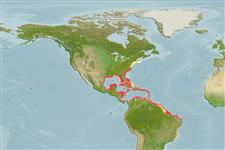>
Eupercaria/misc (Various families in series Eupercaria) >
Lutjanidae (Snappers) > Lutjaninae
Etymology: Lutjanus: Malay, ikan lutjan, name of a fish.
More on author: Walbaum.
Environment: milieu / climate zone / depth range / distribution range
Ecologia
marinhas; estuarina associadas(os) a recifes; intervalo de profundidade 2 - 63 m (Ref. 9626). Subtropical; 42°N - 19°S, 98°W - 31°W (Ref. 55)
Western Atlantic: north to Massachusetts, USA (rare in Florida) and south to Trinidad and northern Brazil.
Length at first maturity / Tamanho / Peso / Idade
Maturity: Lm 25.0 range ? - ? cm
Max length : 79.1 cm FL macho/indeterminado; (Ref. 69373); common length : 35.0 cm TL macho/indeterminado; (Ref. 55); peso máx. Publicado: 10.8 kg (Ref. 26340); Idade máx. registada: 42 anos (Ref. 128039)
Espinhos dorsais (total) : 10; Raios dorsais moles (total) : 14; Espinhos anais: 3; Raios anais moles: 8. Snout long and pointed, mouth large. One of the upper pairs of canine teeth notably enlarged, visible when mouth is close. Preopercular notch and knob weak. Pectoral fins long, reaching the level of anus. Scale rows on back parallel to lateral line, at least anteriorly. Olive gray to brownish on upper back and sides, with eight narrow, pale vertical bars which may be faint or absent in large adults. A solid or broken blue line which may disappear with growth, runs under the eye.
Adults occur in shallow, clear, warm, coastal waters over coral reefs. Often near the shelter of elkhorn corals and gorgonians (Ref. 9710). Juveniles are encountered over sand bottoms with or without seagrass (Thalassia), and over muddy bottoms of lagoons or mangrove areas. Young sometimes enter brackish waters. Sometimes form resting aggregations during the day. Feed on fishes, shrimps, crabs, worms, gastropods and cephalopods. Considered a good food fish, it is marketed fresh or frozen (Ref. 55). Maximum length for female taken from Ref. 3093.
Allen, G.R., 1985. FAO Species Catalogue. Vol. 6. Snappers of the world. An annotated and illustrated catalogue of lutjanid species known to date. FAO Fish. Synop. 125(6):208 p. Rome: FAO. (Ref. 55)
Categoria na Lista Vermelha da IUCN (Ref. 130435)
Ameaça para o homem
Reports of ciguatera poisoning (Ref. 30911)
Utilização humana
Pescarias: espécies comerciais
Ferramentas
Relatórios especiais
Descarregue XML
Fontes da internet
Estimates based on models
Preferred temperature (Ref.
123201): 23.3 - 28, mean 26.4 °C (based on 412 cells).
Phylogenetic diversity index (Ref.
82804): PD
50 = 0.5000 [Uniqueness, from 0.5 = low to 2.0 = high].
Bayesian length-weight: a=0.01479 (0.01312 - 0.01668), b=2.97 (2.95 - 2.99), in cm total length, based on LWR estimates for this species (Ref.
93245).
Nível Trófico (Ref.
69278): 4.3 ±0.4 se; based on diet studies.
Generation time: 9.2 ( na - na) years. Estimated as median ln(3)/K based on 1
growth studies.
Resiliência (Ref.
120179): Baixo, tempo mínimo de duplicação da população 4,5 - 14 anos (Preliminary K or Fecundity.).
Prior r = 0.60, 95% CL = 0.39 - 0.89, Based on 1 data-limited stock assessment.
Fishing Vulnerability (Ref.
59153): High vulnerability (62 of 100).
Nutrients (Ref.
124155): Calcium = 17.6 [9.5, 30.2] mg/100g; Iron = 0.333 [0.194, 0.618] mg/100g; Protein = 19.6 [18.1, 21.0] %; Omega3 = 0.21 [0.12, 0.36] g/100g; Selenium = 28.8 [14.3, 56.3] μg/100g; VitaminA = 90.2 [15.2, 455.2] μg/100g; Zinc = 0.26 [0.18, 0.40] mg/100g (wet weight);
